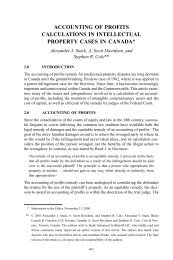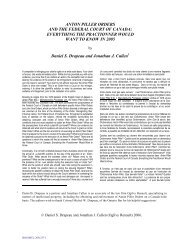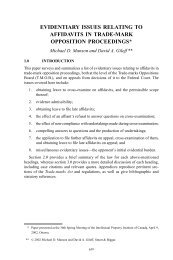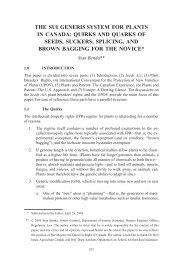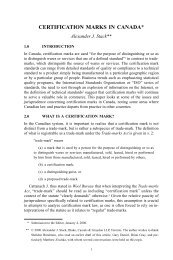A Comparative Overview of Canadian, US and European ...
A Comparative Overview of Canadian, US and European ...
A Comparative Overview of Canadian, US and European ...
Create successful ePaper yourself
Turn your PDF publications into a flip-book with our unique Google optimized e-Paper software.
II. Pharma-Biotech<br />
Issues<br />
Statutory Subject Matter<br />
Canada United States Europe<br />
Higher life forms Higher life forms (i.e. a genetically<br />
modified mouse) are not patentable.<br />
However, the cells <strong>of</strong> higher life forms are<br />
patentable. The net result is that a<br />
genetically modified higher life form will be<br />
patentable, so long as the cells are<br />
claimed rather than the plant or animal<br />
itself.<br />
Methods <strong>of</strong> medical<br />
treatment<br />
At one time the Patent Act provided that<br />
substances intended for medicine could<br />
not be claimed as compounds as such.<br />
The Supreme Court, relying on this<br />
provision, held that methods <strong>of</strong> medical or<br />
surgical treatment are also unpatentable. 8<br />
That section <strong>of</strong> the Act was repealed in<br />
1987, with effect from 1991. There have<br />
been few cases since then on whether<br />
methods <strong>of</strong> medical treatment are<br />
patentable, in light <strong>of</strong> the repeal <strong>of</strong> this<br />
provision. One Federal Court decision has<br />
held that methods <strong>of</strong> medical treatment<br />
involving pr<strong>of</strong>essional skill (in particular, a<br />
drug dosage regime) are unpatentable. 9<br />
Claims framed in terms <strong>of</strong> “use” rather<br />
than a method <strong>of</strong> treatment may be<br />
allowable.<br />
Stem cells In its Harvard Mouse decision, the<br />
Supreme Court <strong>of</strong> Canada has said that<br />
“human life is not patentable.” It is not<br />
clear whether this means that stem cells<br />
are not patentable. The Patent Office<br />
Higher life forms are patentable. The EPC Art 53 says that “plant or animal<br />
varieties or essentially biological<br />
processes for the production <strong>of</strong> plants or<br />
animals” are not patentable. The EPO<br />
Board <strong>of</strong> Appeal has interpreted this to<br />
mean that higher life forms that are the<br />
product <strong>of</strong> traditional cross-breeding are<br />
not patentable, but higher life forms that<br />
are the product <strong>of</strong> genetic engineering are<br />
patentable.<br />
Methods <strong>of</strong> surgical <strong>and</strong> medical treatment are<br />
patentable. However, medical practitioners have<br />
a specific defence <strong>and</strong> cannot be sued for using<br />
patented methods. 10<br />
There is no particular subject matter restriction<br />
affecting stem cells.<br />
Methods for treatment <strong>of</strong> the human or<br />
animal body by surgery or therapy <strong>and</strong><br />
diagnostic methods practiced on the<br />
human <strong>and</strong> animal body are not<br />
patentable. However, these exclusions are<br />
interpreted narrowly by the EPO <strong>and</strong><br />
Enlarged Board <strong>of</strong> Appeals.<br />
The EPO Enlarged Board <strong>of</strong> Appeal has<br />
held that a dosage regime is patentable. 11<br />
The Enlarged Board <strong>of</strong> Appeal has held<br />
that new methods during examination<br />
phase to collect clinical data <strong>of</strong> a human<br />
being or animal may be patentable<br />
inventions, <strong>and</strong> that methods cannot be<br />
excluded merely due to fact they include<br />
steps that depend <strong>of</strong> participation <strong>of</strong> a<br />
medical or veterinary practitioner. 12<br />
The EPO Enlarged Board <strong>of</strong> Appeal has<br />
held that stem cells which could only be<br />
obtained from a method which involved<br />
the destruction <strong>of</strong> human embryos are not<br />
patentable. Beyond this basic principle,<br />
This is a brief <strong>and</strong> very simplified summary <strong>of</strong> selected aspects <strong>of</strong> the three patent systems. It is intended for general informational purposes <strong>and</strong> should not be<br />
used as a basis for taking decisions with regards to any specific cases. Qualified advice should be sought regarding any specific fact situations. All references<br />
WSLegal\049190\00037\8068137v1<br />
to CETA are based on our underst<strong>and</strong>ing <strong>of</strong> the provisions <strong>of</strong> CETA, as determined from sources available on the Internet. IPIC ©2012<br />
15/24



